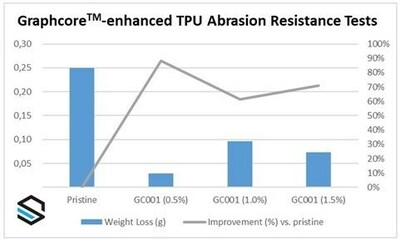Black Swan is pleased to announce its latest version of GraphCore
™001 graphene nanosheet material, when used as an additive in thermoplastic polyurethane (TPU), can increase the wear resistance of TPU by 60% to 80%. The company has previously said that at a 1% addition ratio (the amount of additive material added to the TPU), the performance of the TPU is enhanced by 45%.
TPU is a thermoplastic elastomer that combines some properties of plastic and rubber. It is tough, soft, durable, abrasion resistant, oil and lubricant resistant. These unique properties combine to make TPU ideal for a variety of applications, such as automotive, sports equipment, textile coating and mobile phones.
Simon, President and CEO, Black Swan
Marcotte said: “Today’s performance results allow us to realize that graphene can revolutionize the huge polymer industry. In addition to improving wear resistance, graphene also exhibits other advantages, such as weight reduction, cost savings, improved precision, Breathability and thermal conductivity, all of which can improve existing markets for products and pave the way for new applications.”
The fabrication and subsequent testing of the graphene-enhanced TPU material was carried out independently at the Graphene Engineering Innovation Center (GEIC) at the University of Manchester, UK. The precise type of TPU selected for the trial is currently being used in mobile devices and extruded sheet, which are commonly used in many industries from packaging to transportation and construction materials. Graphene-enhanced TPU materials were fabricated from masterbatches and then molded for trials based on additions of 0.5%, 1.0% and 1.5%.
The results are shown in Figure 1 below, showing that all graphene-added TPU materials have improved performance compared to pristine levels.

Wear test according to ISO 5470 – 1:2016 –
The norm for Taber wear. 3000 grinding cycles were performed using standard grinding wheels, each having a weight of 1000 grams. Weight loss was recorded after every 1000 cycles. Between each 1000 cycles, the wheel was sanded with standard sandpaper for 50 cycles; at the beginning of each new test, the sandpaper was changed.



 微信扫一扫打赏
微信扫一扫打赏
